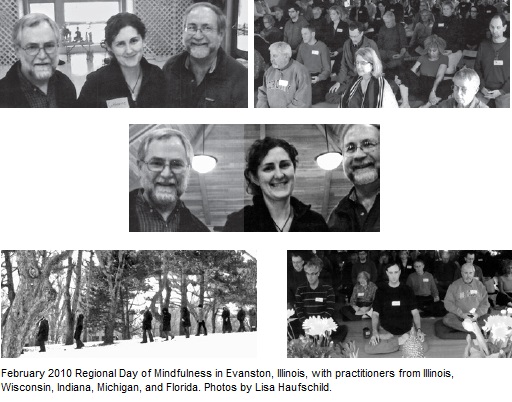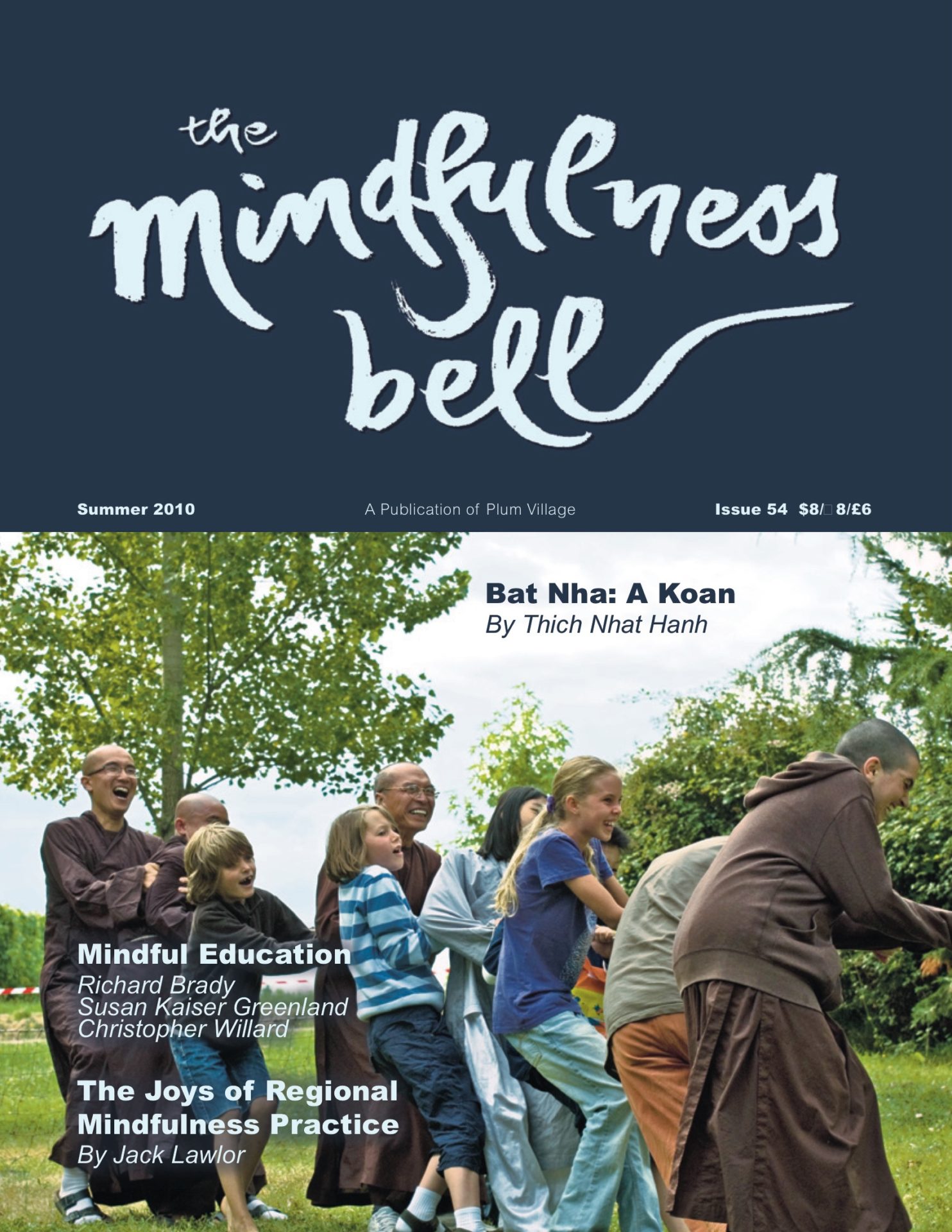By Jack Lawlor
We know that practicing without a Sangha is difficult. That is why we try our best to set up Sanghas where we live. To be an Order of Interbeing member is wonderful. Wonderful, not because we have the title of OI membership but in that we have a chance to practice. As an OI member you must now begin to support a practice group or to organize one if none exists in your area.
By Jack Lawlor
We know that practicing without a Sangha is difficult. That is why we try our best to set up Sanghas where we live. To be an Order of Interbeing member is wonderful. Wonderful, not because we have the title of OI membership but in that we have a chance to practice. As an OI member you must now begin to support a practice group or to organize one if none exists in your area. It does not mean anything to be an OI member if you do not do this in your area. So if we know what it really means to be a Sangha-builder, an OI member, or a Dharma teacher, it is a very good thing. To receive the Mindfulness Trainings transmission and a brown jacket and decide not to build a Sangha would be like getting a student identity card at a university and not using the library or going to class, but telling people that you are a student of a very famous university. It would be very funny. Sangha building is what we do. It is the practice.
--Ven. Thich Nhat Hanh

Sometimes, in the wake of receiving ordination into the Order of Interbeing, a new ordinee can feel a bit lost. New OI members express their desire to be of help but sometimes don’t know what to devote their time and energy to.
Let’s not forget Thay’s observation about the Order of Interbeing, that “Sangha building is what we do.” The need for Sangha builders—and where Sanghas already exist, Sangha nurturers—is hidden in plain sight. It is a life’s work, since there are so many needs and opportunities. There is plenty to do!
We all remember that our interest in joining the Order was to express our bodhicitta, our heart and mind of love, which aspires to practice mindfulness not only for our own sake but also for the benefit of others. As the Order’s charter describes, “With the aspiration of a bodhisattva, members of the Order seek to change themselves in order to change society in the direction of compassion and understanding by living a joyful and mindful life.”
We may have forgotten the historic interrelationship between the Order and local Sanghas, with the result that we may have not yet applied our time, energy, and talents to help nourish existing local spiritual communities or help create new ones where needed, and where doing so will not fracture an existing healthy Sangha. We may forget from time to time that the Sangha is one of the Three Jewels in the Buddhist tradition and that most of the Buddha’s life was devoted to living in the context of spiritual communities. As students of Thay we are encouraged to enjoy a Sangha-based practice and to remember that Sangha building is part of the Order’s very reason for existing. The Order’s charter states that “members are expected to organize and support a local Sangha,” and that Order members are to “help sustain Mindfulness Trainings recitations, Days of Mindfulness and mindfulness retreats.” Hopefully, Order members do these things with a frequency, buoyancy, and dedication that inspire other Sangha members.
Local Sanghas can play a key role in filling the gaps in time between our international and national retreats with Thay. They also provide important practice opportunities for those who cannot afford travel costs or obtain sufficient time off from work or family responsibilities to attend Days of Mindfulness and retreats, either in Plum Village or in the inspiring practice centers created with care and skill at Deer Park Monastery in southern California and Blue Cliff Monastery in New York State.
Sister Sanghas
So let’s be careful not to overlook resources that are reasonably local and readily available! Let’s join hands with sister Sanghas that have evolved in our vicinity, perhaps only two or three hours away. While our local Sangha may not yet have sufficient size or financial resources to organize and support a Day of Mindfulness or retreat at a rented facility, it is likely that when our local Sangha coordinates its efforts with sister Sanghas within a reasonable driving radius, we will have the ability to practice together in grace and ease. Care must be taken to ensure that the events are not too costly or placed too close together on the calendar, in an effort to include as many people as possible.
Our midwestern Sanghas have been practicing as a network of sister Sanghas for many years. Nearly twenty years ago, sister Sanghas in Illinois and Wisconsin first began working together to rent lovely facilities, some of which were surrounded by trees and wildlife, to accomplish together what may not have been feasible alone. Over the past sixteen years more than seventy “regional” multi-Sangha Days of Mindfulness and overnight retreats have been held in Illinois, Wisconsin, Michigan, Indiana and Kentucky, usually attracting between 60 and 100 participants per event. More and more Sanghas are joining in, including Sanghas in Minnesota and Iowa. The sincerity, joy, and ease manifested at each event are evocative of mindfulness practice at our root practice center, Plum Village. Events are facilitated by our local lay Dharma teachers and, from time to time, by visiting members of the monastic community, including Sister Annabel and Sister Jina. We’ve also enjoyed four visits by Thay.
When we hear that a developing local Sangha would appreciate help, older Sanghas are happy to provide it. However, Order members are always careful to be deferential to the modest differences in local Sangha practices that have evolved in various locations over the years, and to honor the sincerity and quality of mindfulness practice manifested by local Sangha members who have not elected to join the Order of Interbeing. After all, many local Sanghas functioned for years before joining in collective regional Sangha efforts, and their ways of doing things deserve great respect. Similarly, many local Sangha members who have not chosen to receive ordination have been practicing mindfulness wholeheartedly and consistently for decades.
Trust, Friendship, and Patience
What is the key component of regional Sangha practice? What are the secrets of success? There are a number of contributing factors, but I have come to the conclusion that trust, friendship, and patience are the key components of enduring success.
There is a beautiful term in the Pali language that describes spiritual friends: kalyana mitta. Spiritual friends share the aspiration to cultivate their bodhicitta, the seeds of wisdom and compassion within themselves, not only for their own benefit but for the benefit of others. We can cooperate with each other in building successful Days of Mindfulness, retreats, and local Sanghas in a spirit of friendship and fun! We can get to know and like each other as we work on the details that make a retreat successful.
Success in regional Sangha building may also depend on the organizers’ willingness to let the process evolve in an organic way, attentive to the practitioners and local Sanghas involved, rather than trying to impose a top-down model that does not respect or understand how local Sanghas have developed over time. Those involved in local and regional Sangha building must prioritize the resolve to make mindfulness practice available to as many people as possible for the prime purpose articulated by the Buddha—the transformation of suffering. The purpose behind our efforts should be this simple, this pure. The intentions of genuine Sangha builders are described in the Avatamsaka Sutra:
Not seeking the objects of desire or positions of authority,
Wealth, personal enjoyment, or fame,
It is only to forever annihilate miseries,
And to benefit the world that they arouse their will.
Patience is another helpful ingredient. Regional Sangha building need not be approached in a spirit of rushing, but in the spirit of kalyana mitta, friends on the path, embarking on a spiritual journey together in mindfulness. Our root teacher, Ven. Thich Nhat Hanh, never seems to rush, not even at airports! Yet think of what he has accomplished during his time in the West, and the array of local Sanghas he has inspired that gleam like a string of pearls, like a jeweled Net of Indra across the world, deserving of our care and attention.

Jack Lawlor, True Direction, has practiced in organized Sanghas since the mid-1970s. Jack was a co-founder of Lakeside Buddha Sangha in Evanston, Illinois, and was ordained as a Dharma Teacher by Thay in 1992. In 2000, he collaborated with Thay and Sanghas throughout the world in compiling the anthology on Sangha building entitled Friends on the Path: Living Spiritual Communities, published by Parallax Press.

